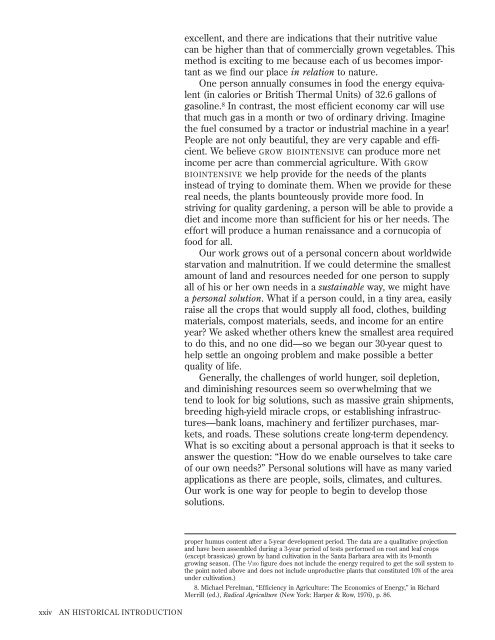How to Grow More Vegetables : And Fruits, Nuts ... - Shroomery
How to Grow More Vegetables : And Fruits, Nuts ... - Shroomery
How to Grow More Vegetables : And Fruits, Nuts ... - Shroomery
Create successful ePaper yourself
Turn your PDF publications into a flip-book with our unique Google optimized e-Paper software.
xxiv AN HISTORICAL INTRODUCTION<br />
excellent, and there are indications that their nutritive value<br />
can be higher than that of commercially grown vegetables. This<br />
method is exciting <strong>to</strong> me because each of us becomes important<br />
as we find our place in relation <strong>to</strong> nature.<br />
One person annually consumes in food the energy equivalent<br />
(in calories or British Thermal Units) of 32.6 gallons of<br />
gasoline. 8 In contrast, the most efficient economy car will use<br />
that much gas in a month or two of ordinary driving. Imagine<br />
the fuel consumed by a trac<strong>to</strong>r or industrial machine in a year!<br />
People are not only beautiful, they are very capable and efficient.<br />
We believe GROW BIOINTENSIVE can produce more net<br />
income per acre than commercial agriculture. With GROW<br />
BIOINTENSIVE we help provide for the needs of the plants<br />
instead of trying <strong>to</strong> dominate them. When we provide for these<br />
real needs, the plants bounteously provide more food. In<br />
striving for quality gardening, a person will be able <strong>to</strong> provide a<br />
diet and income more than sufficient for his or her needs. The<br />
effort will produce a human renaissance and a cornucopia of<br />
food for all.<br />
Our work grows out of a personal concern about worldwide<br />
starvation and malnutrition. If we could determine the smallest<br />
amount of land and resources needed for one person <strong>to</strong> supply<br />
all of his or her own needs in a sustainable way, we might have<br />
a personal solution. What if a person could, in a tiny area, easily<br />
raise all the crops that would supply all food, clothes, building<br />
materials, compost materials, seeds, and income for an entire<br />
year? We asked whether others knew the smallest area required<br />
<strong>to</strong> do this, and no one did—so we began our 30-year quest <strong>to</strong><br />
help settle an ongoing problem and make possible a better<br />
quality of life.<br />
Generally, the challenges of world hunger, soil depletion,<br />
and diminishing resources seem so overwhelming that we<br />
tend <strong>to</strong> look for big solutions, such as massive grain shipments,<br />
breeding high-yield miracle crops, or establishing infrastructures—bank<br />
loans, machinery and fertilizer purchases, markets,<br />
and roads. These solutions create long-term dependency.<br />
What is so exciting about a personal approach is that it seeks <strong>to</strong><br />
answer the question: “<strong>How</strong> do we enable ourselves <strong>to</strong> take care<br />
of our own needs?” Personal solutions will have as many varied<br />
applications as there are people, soils, climates, and cultures.<br />
Our work is one way for people <strong>to</strong> begin <strong>to</strong> develop those<br />
solutions.<br />
proper humus content after a 5-year development period. The data are a qualitative projection<br />
and have been assembled during a 3-year period of tests performed on root and leaf crops<br />
(except brassicas) grown by hand cultivation in the Santa Barbara area with its 9-month<br />
growing season. (The 1/100 figure does not include the energy required <strong>to</strong> get the soil system <strong>to</strong><br />
the point noted above and does not include unproductive plants that constituted 10% of the area<br />
under cultivation.)<br />
8. Michael Perelman, “Efficiency in Agriculture: The Economics of Energy,” in Richard<br />
Merrill (ed.), Radical Agriculture (New York: Harper & Row, 1976), p. 86.












